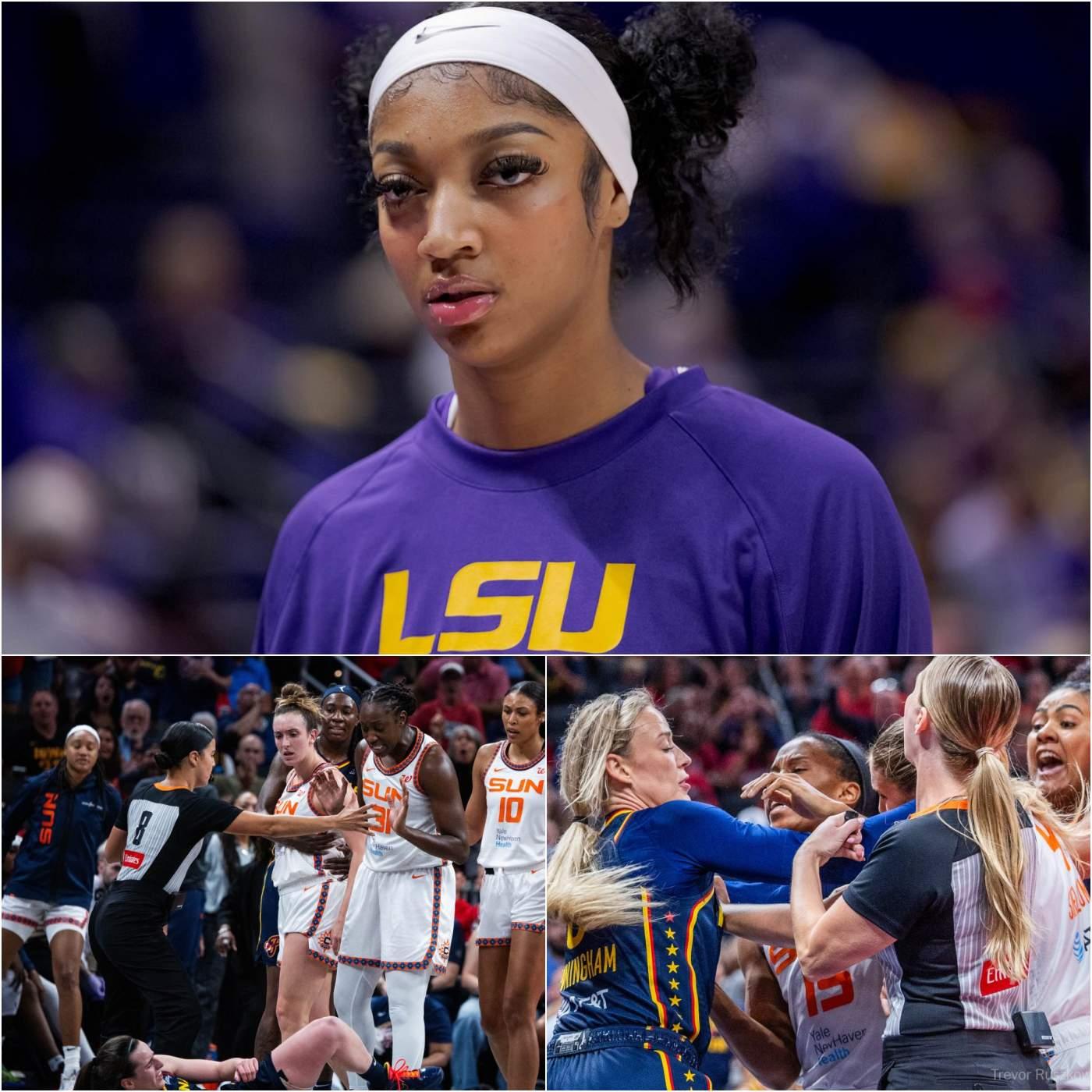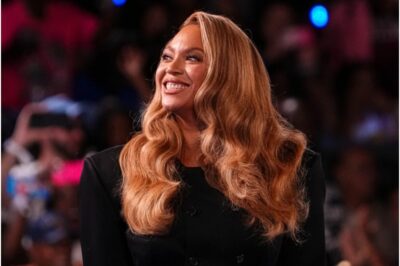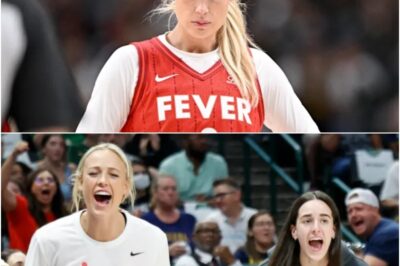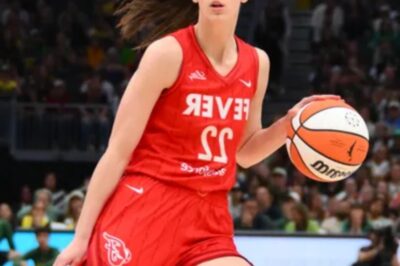
It was supposed to be just another hotly contested night in the WNBA, but what unfolded during the Fever-Sun game has turned into one of the most explosive controversies the league has ever seen—and now, the eyes of the sports world are fixed squarely on Sophie Cunningham and Caitlin Clark. In a split-second moment that nobody saw coming, tensions boiled over on the court, and what started as a hard-fought battle for playoff standing quickly spiraled into chaos. Cunningham, known for her grit and loyalty, found herself at the center of it all—thrown out of the game for fighting and, more specifically, for stepping in to defend her teammate, the superstar rookie Caitlin Clark. The incident, captured in a flurry of camera flashes and viral social media clips, has ignited a firestorm of debate about where the line is drawn between passion and poor sportsmanship, and whether the WNBA is prepared to handle the fallout.
The game itself had been a powder keg from the opening tip. Both teams were desperate for a win, and the physicality was evident from the start. Clark, as always, drew the lion’s share of attention—her every move shadowed by defenders, her every word scrutinized by fans and critics alike. But it was Cunningham’s reaction, in the heat of the moment, that would steal the headlines. Midway through the third quarter, after a particularly rough exchange under the basket, Cunningham charged to Clark’s defense, shoving a Sun player and sparking a full-blown scuffle. The referees wasted no time: Cunningham was ejected, and the crowd erupted in a mix of boos and cheers. It was the kind of incident you rarely see in the WNBA, a league that prides itself on professionalism and composure, and almost immediately, social media lit up with opinions.
Within hours, Cunningham took to Instagram, posting a message that seemed to come straight from the heart. “I’ll always have my teammate’s back,” she wrote, her words accompanied by a photo of her embracing Clark after the dust settled. The post went viral in minutes, with fans flooding the comments—some hailing her as a hero, others condemning her actions as reckless and unsportsmanlike. It was clear that Cunningham’s gesture had struck a nerve. For every supporter who praised her loyalty, there was a critic who questioned whether violence, even in defense of a teammate, had any place in the game. The debate wasn’t just about one player’s actions; it was about the values the WNBA claims to represent.

But if the story had ended there, it might have blown over in a matter of days. Instead, it took an even more dramatic turn when Angel Reese, one of the league’s brightest young stars and a vocal advocate for player safety, entered the fray. Reese, never one to mince words, took to her own social media channels and called for the WNBA to take unprecedented action—not just suspending Cunningham, but banning both Cunningham and Clark from the league for life. Her reasoning was simple but severe: incidents like this, she argued, threaten the very fabric of professional women’s basketball, sending the wrong message to fans and young athletes everywhere. “If the league won’t protect us, maybe it’s time I walk away,” Reese declared, her words sending shockwaves through the basketball community.
The reaction was immediate and deeply divided. Some fans and commentators rallied behind Reese, insisting that the WNBA needed to set a hard line against on-court violence. They argued that the league’s reputation was on the line, and that anything less than a lifetime ban would be a slap on the wrist. Others, however, felt Reese’s response was far too extreme. They pointed out that high emotions and physical altercations are hardly unique to women’s basketball, and that male athletes are rarely threatened with lifetime bans for similar offenses. For them, Cunningham’s actions were regrettable but understandable—a momentary lapse in the heat of competition, not a career-ending crime.
As the debate raged online, the WNBA found itself under unprecedented pressure to respond. The league, long celebrated for its progressive stance on social issues and its commitment to player empowerment, now faced a crisis that threatened to undermine everything it had built. Within hours of Reese’s ultimatum, the WNBA’s CEO issued a public statement that stunned everyone. While the details were initially vague, the message was clear: the league would launch a full-scale investigation into the Fever-Sun altercation, promising swift and decisive action to ensure the safety and integrity of its players.
That announcement only fanned the flames, as speculation ran wild about what measures the WNBA might take. Would Cunningham and Clark face lengthy suspensions, or even the lifetime bans Reese demanded? Would the league’s response satisfy those calling for accountability, or would it alienate the players and fans who saw the incident as a symptom of deeper issues within the sport? As reporters scrambled for answers and insiders whispered about closed-door meetings, one thing became obvious: the WNBA was at a crossroads, and whatever happened next would shape its identity for years to come.
Meanwhile, the players themselves were left to navigate the fallout. Cunningham, for her part, remained unapologetic, doubling down on her support for Clark and her belief that teammates should always stand up for each other. Clark, thrust into the spotlight yet again, tried to deflect attention back to the game, but her every move was dissected by a media eager for the next twist in the story. Angel Reese, undeterred by the backlash, stood firm in her convictions, insisting that she would not return to the court until the league took meaningful action to protect its athletes.
As the days passed, the story only grew more complicated. Former players weighed in, some recalling their own experiences with on-court altercations and the challenges of balancing competitiveness with sportsmanship. Coaches and league officials debated behind the scenes, acutely aware that whatever decision they made would be scrutinized not just by basketball fans, but by the broader public. Sponsors and partners watched nervously, worried that the controversy could tarnish the league’s image and alienate its growing fan base.
Through it all, the WNBA’s leadership faced an impossible balancing act. On one hand, they needed to demonstrate that player safety was non-negotiable, and that violence would not be tolerated. On the other, they were acutely aware that the league’s appeal rests in part on the passion and intensity of its athletes—the very qualities that had fueled the Fever-Sun altercation in the first place. To come down too hard risked stifling that spirit; to go too soft risked undermining the league’s credibility.
In the end, the WNBA’s response will be remembered as a defining moment—not just for Cunningham, Clark, and Reese, but for the league as a whole. The investigation, still ongoing as of this writing, has already prompted soul-searching conversations about what it means to compete at the highest level, and what kind of example the league wants to set for the next generation. Some see the incident as a wake-up call, a reminder that the stakes are higher than ever and that the league’s growing profile brings new challenges. Others see it as an overblown controversy, a tempest in a teapot fueled by social media outrage and the 24-hour news cycle.
But one thing is certain: the Fever-Sun altercation has forced the WNBA to confront questions it can no longer ignore. How will the league handle player conduct in an era of unprecedented scrutiny? Can it protect its athletes without sacrificing the competitive fire that makes the sport so compelling? And perhaps most importantly, can it navigate the tricky terrain of public opinion while staying true to its core values?
As fans and players alike wait for answers, the league’s next steps will be watched more closely than ever before. For Cunningham and Clark, the outcome could mean anything from a brief suspension to the end of their WNBA careers. For Reese, the decision will determine whether she continues to be one of the league’s brightest stars or walks away at the height of her powers. For the WNBA, the stakes are even higher: the future of the league, and its place in the world of professional sports, hangs in the balance.
In the end, the Fever-Sun incident may be remembered not just for the chaos it unleashed, but for the conversations it started—about loyalty, about sportsmanship, about what it means to fight for your teammates and your beliefs. Whether the league emerges stronger or more divided remains to be seen. But one thing’s for sure: the WNBA will never be quite the same.
News
PHOTO: Kate Martin’s Girlfriend Turns Heads With Stunning New Look and Social Media Is Eating It Up
Kate Martin, the former college teammate of Caitlin Clark turned WNBA guard, is having a solid 2025 season. The 6-foot, 172-pound guard played her…
Terrifying Videos Show Beyoncé “Fighting For Her Life” Stranded Mid-Air As Car Malfunctions During Houston Concert
Beyoncé stranded mid-air (Photo By Imagn Images and X) Beyoncé’s significant return to Houston became a moment fans won’t forget,…
Everyone Is Rushing to Congratulate Sophie Cunningham After Huge News Goes Public and It’s Blowing Up Online
Congratulations are pouring in for WNBA star Sophie Cunningham on Sunday evening. Cunningham, 28, is in her first year with the Indiana…
BREAKING: Jaw-Dropping Female Tennessee Vols Fan Who Stole Hearts vs. Georgia Has Been Identified, And Her Bikini Photos Are Something Else (PICS)
Tennessee Vols fan (Photo via @abby.beck14/Instagram) The Tennessee Vols fan who went viral online ahead of the program’s clash against…
Sophie Cunningham Leaves Fans in Tears With Brutally Honest Confession About Her Relationship Status
Key Indiana Fever reserve Sophie Cunningham has captured headlines this week after standing up for teammate Caitlin Clark following a hard foul against…
VIDEO: New Footage Has Fans Worried Caitlin Clark’s Groin Injury Is Way Worse Than Anyone Thought
Caitlin Clark (Photo Via Imagn Images and X) Things were finally looking up for the Indiana Fever. Sitting at 8-8 and…
End of content
No more pages to load












